76 years after the first use of a nuclear bomb by mankind, the knowledge required to manufacture such a weapon is freely available to all, but it still remains an expensive and complex enterprise, requiring enormous resources. What makes it so complicated?
Nuclear bombs are the most powerful weapons mankind has ever developed, and it seems that no new weapons in the foreseeable future are likely to become contenders for this title. The power of nuclear weapons exceeds that of conventional weapons by many orders of magnitude, both in terms of the energy released from them and in the extent of destruction and death they are capable of inflicting. Luckily for humanity, they are very difficult to develop, and strict international supervision has so far managed to limit their spread to relatively few countries.
All nuclear weapons are based on the same basic principle: releasing a vast amount of energy within a very short period of time – less than a millionth of a second. The source of this energy are nuclear reactions, which change the atomic nucleus. That is also how ‘atomic bombs’ differ from the explosion reactions that occur in conventional explosives, where only the bonds between atoms are changed, but not their basic structure.
There are many nuclear reactions, however only two of them are important for the production of nuclear weapons: nuclear fission, which all nuclear weapons rely on; and nuclear fusion, which occurs only in hydrogen bombs.
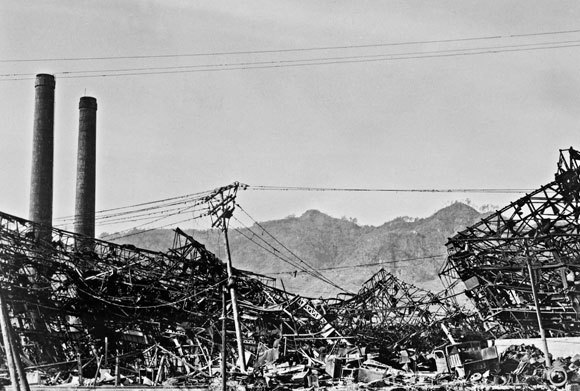
Release of a vast amount of energy during a short time. The damage of the nuclear bomb in Nagasaki, after three years. | Source: US NATIONAL ARCHIVES AND RECORDS ADMINISTRATION / SCIENCE PHOTO LIBRARY
Fission bomb: a chain reaction
In order to carry out the nuclear fission reaction in a weapon, fissionable materials - heavy elements that tend to degrade to lighter elements, are required. In reality, the only practical materials for this purpose are certain isotopes of uranium or plutonium.
Isotopes are atoms that contain a similar number of protons, and therefore belong to the same element, but differ in the number of their neutrons. Their chemical properties are usually very similar and it is hard to distinguish between them. Heavy elements such as uranium (the 92nd element in the periodic table) and plutonium (element 94), have many isotopes: for example, any atom with a nucleus of 92 protons is uranium, but the number of neutrons can be larger or smaller, and each such atom is an isotope of uranium.
The question of whether or not a material is fissile depends on its nuclear structure, therefore the identity of the isotope is very important, as not all isotopes are fissile. Uranium and plutonium are the only fissile materials that have been used for creating fission reactions, since elements lighter than uranium are not fissile while elements heavier than plutonium occur very rarely in nature, are practically non-existent, and are too difficult to produce in useful quantities.
Plutonium is usually an artificial element, but it can be produced relatively easily in nuclear reactors. Uranium, on the other hand, is relatively abundant on Earth, but almost all natural uranium, more than 99 percent, is uranium-238, which is not fissionable. The only naturally occurring fissionable material is the isotope uranium-235, but it constitutes only a tiny fraction of the naturally occurring uranium.
Fissile materials are characterized by the following chemical property: when a neutron collides with their atomic nucleus, a significant chance exists (over 60 percent) for the nucleus to undergo a fission reaction, i.e. to split into two smaller – but not equal nuclei. During this process additional neutrons are emitted and a lot of energy is released. How much? Splitting all the atoms in one kilogram of uranium will produce about one million times more energy than the energy produced by burning a kilogram of coal. The extra neutrons can collide with other atoms and cause subsequent fissions. The number of additional neutrons generated is not constant since there are many ways in which the nucleus can split, but on average it is usually 2.5-3 neutrons, depending on the kind of fissile material. The total number of neutrons and protons in the products is equal to their original number.
Since each fission process requires one neutron but emits several neutrons, an increasing chain reaction is generated, assuming that the neutrons formed as a result of fission cause, on average, more than one additional fission in neighboring atoms. Such an increasing chain reaction will get out of control very quickly – in less than a millionth of a second – and will generate a huge number of fissions and a significant release of energy. The process is so fast due to the high speed of the emitted neutrons, about 14 thousand kilometers per second. Given the central role of neutrons in the chain reaction, it is no wonder that James Chadwick, who first discovered them, also took part in developing the first fission bombs, in the Manhattan Project during World War II.
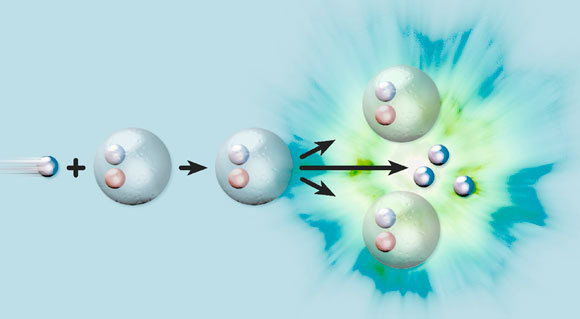
An addition of one neutron to the nucleus causes it to split into two nuclei (krypton and barium) and to emit energy and three neutrons | Illustration: CLAUS LUNAU / SCIENCE PHOTO LIBRARY
From theory to practice
The main factors in generating the chain reaction are the density of the fissionable material and its mass. The reason for this is that part of the neutrons will not generate further fissions, but will escape into the environment. The denser the material, the more likely it is that a neutron will encounter a fissile atom, since the atoms are closer to one another. In addition, the greater the mass of the fissile material, the greater its volume. Therefore the neutron will have to travel a greater distance within the material until it is able to escape into the environment, reducing the likelihood that it will escape without producing fission.
Assuming that the density of the fissile material is constant and its shape spherical, we realize that every fissile material has a critical mass, below which an increasing chain reaction will not occur, only above it. If the mass is large enough, the chain reaction will be extremely fast and will create an explosion that will disperse the fissile material and destroy the conditions required for a nuclear reaction, causing it to stop eventually. The critical mass of fissile materials under conditions relevant for a fission reaction is usually between a few kilograms to a few tens of kilograms (in this link you can play with a critical mass simulation).
Why is it so complicated to produce a fission bomb? First and foremost, due to the extreme difficulty to produce fissile material. To do so, one needs to build a nuclear reactor for plutonium production, or alternatively, one would need to extract from uranium ores the fissile and rare isotope uranium-235, whose nucleus contains 143 neutrons. Only 0.72 percent of the total mass of uranium on Earth is uranium-235. The process of its extraction is called “uranium enrichment”, in which the relative amount of uranium-235 in total uranium is increased, and this is difficult to accomplish.
A nuclear reactor is an expensive and cumbersome tool to operate, especially if it is designed to produce plutonium for nuclear bombs. Also, separating the plutonium formed in it from the rest of the used nuclear fuel is no easy task, and it requires management of very dangerous radioactive materials, and a large, difficult-to-conceal plant.
Uranium enrichment is a complicated process since the chemical properties of uranium isotopes are almost identical, and the differences in their mass are minute. The most efficient process requires using thousands of centrifuges. Such enrichment plants are large and consume a lot of electricity, and it is difficult to keep them secret. It is therefore not easy, even for sovereign countries, to produce fissile materials clandestinely, and there is almost no chance that a terrorist organization will be able to independently produce fissile material for a bomb, without a country’s resources behind it.
Even after having produced enough fissile material, the technical challenge of manufacturing the bomb itself remains. Theoretically, all that is needed is to produce a mass greater than the critical one, and to shoot a neutron at it at the right time, in order to start a nuclear chain reaction. However, the problem is that neutrons are always around, and are also emitted by the fissile material itself due to chemical processes occurring within it. Therefore, very shortly after a critical mass is assembled, a neutron will inevitably emerge and cause an explosion. The resulting explosion will disperse the fissile material (and the unfortunate technician who put it together), and will be relatively small – equivalent to a few kilograms of ordinary explosives
This challenge was already overcome in the Manhattan Project, in which the first nuclear bombs were built, led by the physicist Robert Oppenheimer. Two different methods were developed to overcome this obstacle. The first was the gun assembly, which is only applicable to uranium. This technique requires shooting a subcritical mass of uranium onto another subcritical piece, causing them to unite and create a supercritical mass. In the “Little Boy” bomb, dropped on the city of Hiroshima in Japan, this method was used. About 64 kilograms of enriched uranium exploded at a magnitude of about 15 thousand tons of TNT – a conventional explosive that serves as a standard for measuring the intensity of explosions.
In the second bomb (Fat Man), dropped on the city of Nagasaki, implosion assembly was implemented. In this method, a large amount (about 2.5 tons in the case of Nagasaki) of explosives are exploded at once in order to compress and increase the density of a subcritical ball of plutonium, so that it becomes supercritical. Thus, they managed to compress 6.5 kilograms of plutonium to a density about 2.5 times its initial value, up to about 40 grams per cubic centimeter. The result was an explosion with a magnitude of 21 thousand tons of TNT. This method is applicable to any fissile material, and is considered much more efficient compared to the gun assembly technique.
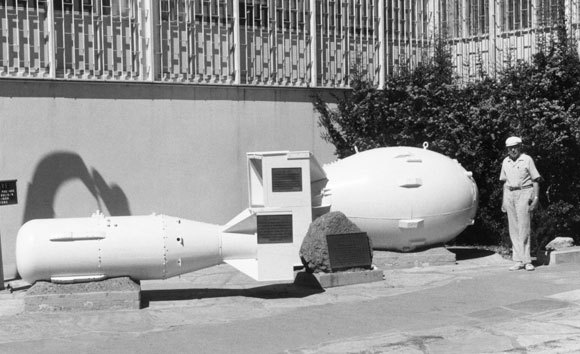
Models of the “Fat Man” (right) and “Little Boy” bombs on the Manhattan Project site at Los Alamos. Next to them is the Italian-American scientist Emilio Segre, one of the longstanding members of the Manhattan Project | Source: EMILIO SEGRE VISUAL ARCHIVES / AMERICAN INSTITUTE OF PHYSICS / SCIENCE PHOTO LIBRARY
From fission to fusion
Hydrogen bombs also release a vast amount of energy in a short period of time, but instead of splitting heavy nuclei, they fuse light atoms together: hydrogen nuclei fuse together to form a helium nucleus, which weighs less. Here too, the difference in mass translates into a vast amount of energy, emitted in a huge explosion. The advantage of this reaction is that it is much easier to produce the fuel for fusion compared to fissile materials. The disadvantage is that in contrast to a fission reaction, nuclear fusion can only occur at very high temperatures and tremendous densities.
These conditions can only be attained by a nuclear explosion, which is based on a nuclear fission chain reaction, and therefore hydrogen bombs include a regular fission bomb which explodes and it is this energy that is used to compress and heats up the hydrogen used as fuel. The resulting nuclear fusion reactions usually emit an amount of energy 10-50 times greater than that emitted by the original fission bomb. The fusion reactions also lead to the emission of neutrons, used to generate further fission. Therefore, advanced fusion bombs can release an amount of energy 20 times greater than the fusion bomb released above Nagasaki, while weighing 20 times less.
Although the process of fusion itself hardly produces any radioactive materials, the concomitant nuclear fission results in hydrogen bombs still producing a very large amount of nuclear fallout.
From a military perspective, an important advantage of a hydrogen bomb is that, in contrast to a fission bomb, the size of which is dictated by critical mass limitations, the only limit on the size and magnitude of the fusion bomb is a derivative of practical considerations of missile and aircraft carrying capacity. Yet building a hydrogen bomb is a much more complicated task than building a regular fission bomb. This is evidenced by the many failures of early nuclear experiments with hydrogen bombs. As far as we know, no nuclear power, perhaps except for North Korea, has failed its first nuclear experiment with a fission bomb.
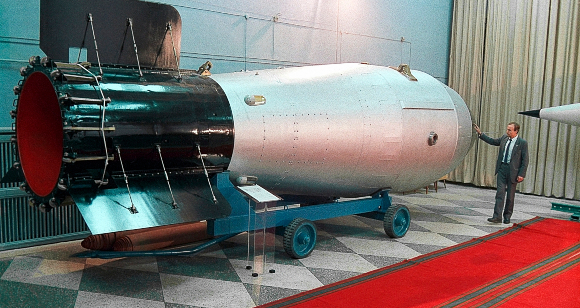
Was never operational. A model of the largest hydrogen bomb in history the Soviet “Tsar Bomba”, in a museum in Russia | Source: SPUTNIK / SCIENCE PHOTO LIBRARY
The global nuclear arsenal
Most modern nuclear bombs are hydrogen bombs. The reason for this is that these bombs are more powerful and physically smaller than bombs that rely entirely on fission. In the past, the US and the Soviet Union have developed hydrogen bombs of tremendous capacity, of many megatons - that is, millions of tons of TNT.
The largest bomb ever tested was named “Tsar Bomba” , and its magnitude reached 50 megatons – 30 thousand times more than the bomb dropped on Hiroshima! It was however created only for Soviet propaganda and was never used by the military. Today there are almost no bombs of such magnitude, and most nuclear weapons are “only” 10-30 times more powerful than those dropped during World War II. In fact, the US and Russia do not have nuclear weapons with a capacity of more than 1.2 megatons. This is because most nuclear missiles today can carry several warheads, and a group of relatively small warheads will produce more damage than one large warhead.
Nearly all nuclear weapons today are designed either as aerial bombs to be carried by aircrafts or as missile warheads. However, other forms of nuclear weapons such as shells, mortars, torpedoes, air-to-air and ground-to-air missiles, as well as small explosive devices carried by one person, and even landmines, have been developed in the past. Most of these uses have died out, as they were designed as a method for compensating for inaccuracy with high destruction intensity. Today thanks to the existence of very precise weapons, the need for most nuclear weapons has been obviated.

A modern ballistic missile can carry eight nuclear warheads. Technicians with a W87 warhead | Source: nuclearweaponarchive.org
Enormous devastation and radiation
In terms of their effect, no significant difference exists between fission bombs and hydrogen bombs. The main factor determining the effect of the bomb is the magnitude of the explosion – the amount of energy released. Most of the energy is converted into thermal radiation – a highly intense heat which burns flammable materials and causes burns even at a great distance from the point of impact, and into kinetic energy in the form of a shockwave which can topple buildings and wreak damage over a range of many kilometers. The human body is fairly resistant to direct shockwave damage, but can be hurt by flying objects and broken glass.
The strong winds generated by a shockwave are also the cause of the mushroom cloud that has become a symbol of nuclear explosions. When a nuclear bomb is detonated above a populated area, as was the case with Hiroshima and Nagasaki, many fires will also be induced, intensifying the damage.
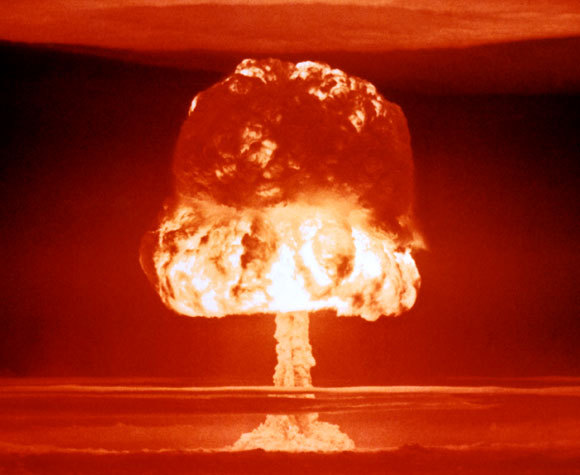
The symbol of many nuclear explosions. The mushroom cloud of the American experiment Castle Romeo at the Bikini Islands in 1954 | Source: United States Department of Energy
The radioactive radiation is a secondary effect of the bomb. In the area of the blast, strong radiation spreads instantly, but within a relatively short range, which is usually significantly smaller than that of the shockwave and heat radiation. The more significant danger stems from the nuclear fallout – radioactive materials that are formed during the fission reactions, mix with dirt, sand and fragments of the bomb itself, and create radioactive dust. The fallout emits strong radiation but it decays relatively quickly and after a few hours its magnitude is reduced to only a tenth of its initial intensity.
The fact that most nuclear weapons are designed to explode at an altitude of hundreds of meters above the ground, rather than on the ground, somewhat reduces the danger of nuclear fallout. Under these circumstances, the fallout is not expected to settle only in the vicinity of the blast area, but is rather dispersed by the wind. Thus, the radiation spreads over a larger area but at lower levels. The radioactivity at a nuclear blast site gradually decays, such that today Hiroshima and Nagasaki are completely safe to live in and are no more radioactive than their surroundings. (You can play with a simulation of nuclear explosions under a variety of conditions)
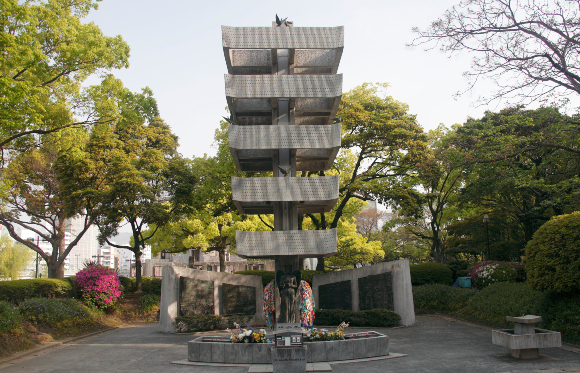
Modern day Hiroshima and Nagasaki are not radioactive. A memorial for the victims of the nuclear bomb in Hiroshima | Source: ANDY CRUMP / SCIENCE PHOTO LIBRARY
A danger during peacetime?
Are nuclear weapons dangerous even when they are not in use, for example when stored in ammunition arsenals? Usually not. Bombs emit very little radiation while in storage. American submarines armed with nuclear warhead cruise missiles, whose crew members spend a long time in close proximity to the warheads, often use a composition of plutonium that emits less radiation than usual (a particularly low percentage of plutonium-240).
The risk of an accident, meaning that a nuclear bomb would explode unintentionally, was relatively significant in the past, but today it is rather low. Warheads today are built so that even a particularly serious accident, such as a crash of the aircraft carrying the bombs, would not lead to an unintentional nuclear explosion. In many cases, an effort is also invested in ensuring that the radioactive fissile material does not disperse to the environment under such a scenario. The nuclear warheads of the nuclear powers are equipped with mechanisms that prevent them from being used unless an appropriate right code is introduced, so that should a hostile or unauthorized person take control of them, he would not be able to detonate them.
During the last few decades there have been many accidents involving nuclear weapons. None of these resulted in a nuclear explosion, although in several cases there was a real danger of this happening. In many of these cases, no radioactive material was spread into the environment.
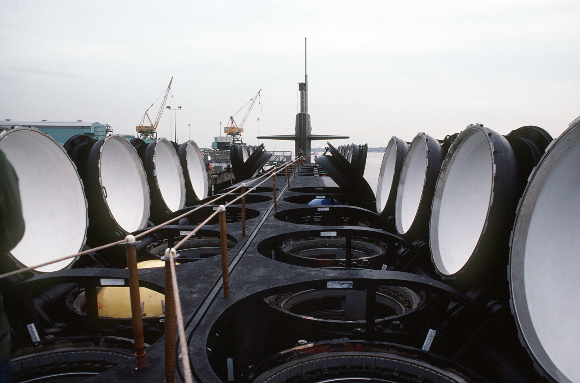
Many safety measures. Missile launch tubes aboard the USS Ohio | Photo: US AIR FORCE / SCIENCE PHOTO LIBRARY
A bomb of peace?
Today, nuclear weapons are intended for military use only, but in the past they were considered for civilian use as well, mostly for quarrying and mining. The main problem is that even when a nuclear device is designed to disperse a minimal amount of radioactive material, the amount emitted is still too high. In addition, there is a risk of nuclear weapon proliferation into the wrong hands, since there is no real difference between a nuclear device for mining and a nuclear bomb. In addition, over the years, international treaties were signed banning nuclear experiments, especially those conducted in the atmosphere. As a consequence, by the ‘70s the US had already abandoned the program to utilize nuclear facilities for civilian use. The Soviet Union had a more extensive plan, but it too was eventually forsaken.
Another use considered for nuclear bombs was to power spaceships. The United States initiated a program called “Project Orion” in the ‘50s, meant to test this option. It was eventually abandoned following the international ban on nuclear experiments in the atmosphere and in space, as well as the ban on operational nuclear weapons in space.
The developments in the development of nuclear weapons also had positive repercussions on civilian life. For example, Teflon, which we all know as a coating for pans, was first used in the Manhattan Project as a coating chemically resistant to fluorine gas, used to enrich uranium.
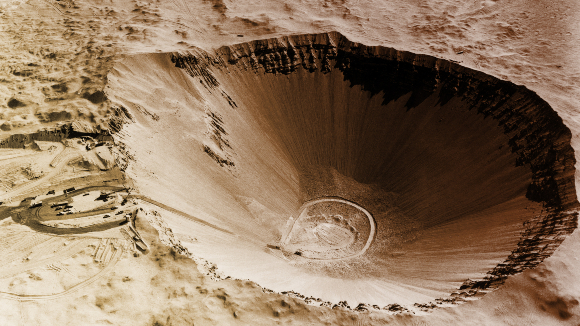
Thoughts on nuclear mining. Sedan crater, 400 meters wide, formed by a controlled nuclear blast in Nevada | Photo: OMIKRON / SCIENCE PHOTO LIBRARY
The nuclear club
Only five countries today are recognized as nuclear powers by international conventions: the US, Russia (and the Soviet Union before it), the UK, France and China. The US and the Soviet Union were the ones who carried out most of the nuclear experiments, mostly in the mid-20th century. The other three carried out a few dozen experiments in total.
Other countries that possess military nuclear capabilities are India, Pakistan and North Korea, all of which carried out very few nuclear tests. South Africa had six nuclear bombs in the ‘80s, but these were dismantles shortly before the end of Apartheid regime. Iran has been subject to economic sanctions due to the suspicion of secretly trying to develop a bomb, but as far as we know today, it has not yet attained such capability. According to foreign publications, the state of Israel is also in possession of nuclear weapons. Other countries, such as Iraq and Syria, tried to develop such a capability in the past but have been stopped.
Finally, the question arises whether it is not dangerous to reveal all of the bomb’s secrets? The answer is a clear-cut no. The information brought here is widely known and things that were secret in the past are common knowledge today. Most of the data on nuclear weapons is not currently classified, except for full blueprints of weapons and relatively advanced ideas, especially in the field of hydrogen bombs. The main principles are known and have been well-understood since the mid 20th century. In fact, unofficial, but likely accurate blueprints of the bombs dropped on Hiroshima and Nagasaki can be even found on Wikipedia.
Since scientific know-how on the bomb’s manufacturing is available to all, the main obstacles faced by any country or organization trying to obtain nuclear weapons are financial, logistical and political. A large part of the information provided in the current article was derived from The Smyth Report, which was made public upon the conclusion of the Manhattan Project and the end of World War II.
By 1964, the US had already carried out an experiment where three young physicists, with no background in the field of nuclear physics, were asked to design a nuclear bomb, based only on information readily available in the scientific literature. Three years later, they submitted a final sketch, which is kept secret to this day, but it seems that it was possible to build a usable bomb based on it. Today, of course, this information is even more available. However, manufacturing fissile material for nuclear weapons was and still is a difficult, expensive and very complicated task. It is to be hoped that even in the future we will not see widespread manufacturing of nuclear weapons, let alone warlike use of it, even if it is unlikely that it will actually destroy humanity.
